|
Yawkey Center for Outpatient Care
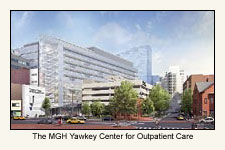 Just a few short months away in October 2004 we will be
moving our practices to the new Yawkey Center for Outpatient Care. This new
state-of-the art facility adjacent to the main campus on Cambridge Street
will be the home to the Cancer Center, Cardiovascular Program, MassGeneral
Hospital for Children, Women's Health and Musculoskeletal Programs. In the
new building we will be nearly doubling our clinical space, giving us the
opportunity to unite the group in one centralized geographic location.
Fantastic! The facility will be the largest and most comprehensive outpatient
center in New England. The center will be comprised of ten floors, and a
six-level, underground parking garage that will accommodate 725 vehicles. Just a few short months away in October 2004 we will be
moving our practices to the new Yawkey Center for Outpatient Care. This new
state-of-the art facility adjacent to the main campus on Cambridge Street
will be the home to the Cancer Center, Cardiovascular Program, MassGeneral
Hospital for Children, Women's Health and Musculoskeletal Programs. In the
new building we will be nearly doubling our clinical space, giving us the
opportunity to unite the group in one centralized geographic location.
Fantastic! The facility will be the largest and most comprehensive outpatient
center in New England. The center will be comprised of ten floors, and a
six-level, underground parking garage that will accommodate 725 vehicles.
SERVICE UPDATES:
Adult Reconstructive (Arthroplasty) Services
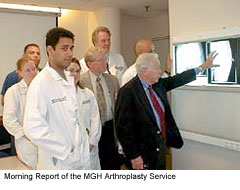 The Arthroplasty Service under the direction of Service
Chief, Andrew Freiberg, MD, has had an impressive and very busy year with
respect to clinical activity and research. We have developed a widely
recognized program in minimally invasive total joint arthroplasty and
continue to work with other departments in the institution to further our
multi-disciplinary approach to patient care. Drs. Freiberg, Dennis Burke,
William Tomford, William Harris, David Lhowe, Murali Jasty, John Siliski
and I participate in the morning Arthroplasty Conference which has continued
to grow in popularity and is recognized as one of the best conferences in the
program. The new multi-disciplinary CAOS Conference (Combined Arthroplasty
Oncology Service Rounds) has added greatly to our capabilities in treating
some of our patients with difficult implant and allograft requirements. The Arthroplasty Service under the direction of Service
Chief, Andrew Freiberg, MD, has had an impressive and very busy year with
respect to clinical activity and research. We have developed a widely
recognized program in minimally invasive total joint arthroplasty and
continue to work with other departments in the institution to further our
multi-disciplinary approach to patient care. Drs. Freiberg, Dennis Burke,
William Tomford, William Harris, David Lhowe, Murali Jasty, John Siliski
and I participate in the morning Arthroplasty Conference which has continued
to grow in popularity and is recognized as one of the best conferences in the
program. The new multi-disciplinary CAOS Conference (Combined Arthroplasty
Oncology Service Rounds) has added greatly to our capabilities in treating
some of our patients with difficult implant and allograft requirements.
There has been a tremendous interest by our patients in the
new MIS 2 Incision Total Hip Arthroplasty procedure. To date we have performed
over 40 cases and look forward to reporting the results of this important
series. Our MIS program was prepared under the supervision of the MGH
Institutional Review Board, and represents one of our best examples of
initiating a new operative procedure that has maximized patient safety and
cross-departmental team work. The MGH Minimally Invasive Arthroplasty
Committee has representation from Orthopaedic Surgery, Nursing, Anesthesia,
Radiology, Physical Therapy, Occupational Therapy and Discharge Planning.
I'll have further information in next year's report.
The new intranet based computerized registry system for hip
and knee arthroplasty patients, Patient View, has been up and running for
over a year. Patient View has revolutionized the collection, organization
and maintenance of data and could serve as a model for a national joint
registry. We are currently collecting data on hip patients and in the very
near future we will expand to include knee, MIS hip arthroplasty, as well
as uni-compartimental arthroplasty. This significant contribution will be
an integral part of the Arthroplasty Service for many years to come. We
are greatly indebted to Dr. William Harris for his contributions in
developing Patient View.
This year's Orthopaedic Research Society (ORS) and American
Academy of Orthopaedic Surgeons (AAOS) Meetings were extremely productive
for the Arthroplasty Service. Members of the Arthroplasty Service had 30
podium, poster, scientific exhibits and group symposia. The Arthroplasty
Service had a spectacular year with respect to peer-reviewed publications,
book chapter and reviews. As part of our educational programs we also gave
numerous national and international lectures in such places as Taiwan,
China, Korea, Japan, Mexico, Italy, and France.
Preparations are underway for the 34th Annual Arthroplasty
Course. This year's offering entitled, "Advances in Arthroplasty: The
Battle of the Bearing Surfaces and Surgical Techniques," will take place
September 29 – October 2, 2004 at the Hyatt Regency Hotel, in Cambridge.
Top local, national and international faculty in the field will present
the latest findings and the newest techniques in total joint arthroplasty.
For further information or to obtain a registration form, contact the
Harvard Medical School, Department of Continuing Medical Education at
(617) 384-8600 or visit them online at http://cme.med.harvard.edu/.
Our research program in crosslinked polyethylenes is
thriving and new applications in total knee arthroplasty, shoulder and
spine surgery are on the horizon. Dr. Harris and his team developed a
new constrained acetabular component that, for the first time, allows
increased range of motion, the use of crosslinked polyethylene, and
provides a powerful constraint to prevent dislocation. With respect to
total knee research, new findings were made concerning unicondylar knee
biomechanics and the importance of an intact ACL, and we completed an
important program studying the biomechanics of campost interactions in
posterior stabilized knees.
Dr. Freiberg reports, "Our future plans include expanding
our clinical practices with an emphasis on state of the art methods of
primary and revision arthroplasty, along with a continued emphasis on
studying advances in bearing surfaces (crosslinked polyethylenes). I
expect we will gain additional clinical and research experience in
intra-operative computer assisted navigation for minimally invasive
surgery. We will continue with sustained efforts at long term follow-up
studies using our Patient View Registry which promises to guide our
clinical studies for many years to come."
Podiatry: Foot and Ankle Services
The Podiatric Service at the MGH has been nationally recognized
for excellence in both clinical care and post-graduate education. Clinical
services include 'high-risk' foot care, sports medicine, biomechanics, foot
orthoses, primary and general foot care and reconstructive foot surgery. As
Division Chief and Program Director of Podiatry, Dr. Robert J. Scardina
oversees the clinical staff at the MGH main campus, the three MGH Health
Centers and the South End Community Health Center. "With the process of
converting our residency training program to a new national model, additional
and more extensive training and educational experiences have been added. Our
ultimate goal is a three year Podiatric Medical and Surgical Residency, leading
to board qualification for our graduates in all three podiatric subspecialties:
medicine, surgery and orthopedics," notes Dr. Scardina.
The Foot and Ankle Service under Service Chief Dr. George
Theodore, continues to provide comprehensive clinical care for patients in
the MGH community and the greater Boston area. The team consists of Dr.
Theodore, Dr. James Heckman, and Dr. Kevin Raskin who has assumed increased
foot and ankle responsibilities. We are actively recruiting an additional
Foot and Ankle Surgeon to supplement and extend the existing capabilities of
the service. We look forward to this new individual's participation in
increasing the service's activities. Dr. Theodore reports, "Clinically, the
focus remains on complex adult foot and ankle problems including chronic
plantar fasciitis, tendinopathies, cartilage injuries of the talus, and
post-traumatic reconstructions. Both traditional techniques of treatment
are being used, as well as newer technologies such as extracorporeal shock
wave treatment, fiberoptic tenosynovectomies, and arthroscopically-assisted
fusions."
The Foot and Ankle Service and the Podiatry Service are also
working to further collaborate in patient care and resident education. The
service works closely with the Sports Medicine service, with which it shares
residents and fellows. In addition, there is also cross-teaching with MGH
Podiatry Unit and Vascular service. The goals for the coming year include:
improved innovations in diabetic foot care, the use of allograft cartilage
transplantation, and the use of shockwave therapy for achilles tendon
disorders. A computerized teaching program in foot and ankle is also being
developed by to provide up to date information for the residents.
Hand and Upper Extremity Services
The Hand and Upper Extremity Service led by Service Chief,
Jesse B. Jupiter, MD, continues to be one of the busiest services in the
department. This past year, Dr. Jupiter was named the Hansjörg Wyss Professor
of Orthopaedic Surgery at Massachusetts General Hospital and Harvard Medical
School, in recognition of his numerous contributions to the department. This
professorship was established through a gift from Mr. Hansjörg Wyss, Chairman
and CEO of Synthes-Stratec, an international manufacturer and distributor of
surgical implants and instruments.
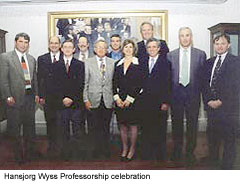 Dr. Jupiter has shown continued dedication and commitment to
the field of orthopaedic surgery and to the department since he was an
orthopaedic resident in the department in the late 1970's. Since 1994, he
has been the Chairman of the Education Committee of the AO/ASIF Foundation.
He is currently a member of the Orthopaedic Surgery Residency Core Curriculum
Committee, the Department Executive Committee, and many prestigious
professional societies. He also serves on a number of editorial boards and
serves as associate editor for the Journal of Orthopaedic Trauma, the Journal
of Orthopaedic Techniques, and the Journal of Reconstructive Microsurgery. A
prolific writer, Dr. Jupiter has added greatly to the orthopaedic literature. Dr. Jupiter has shown continued dedication and commitment to
the field of orthopaedic surgery and to the department since he was an
orthopaedic resident in the department in the late 1970's. Since 1994, he
has been the Chairman of the Education Committee of the AO/ASIF Foundation.
He is currently a member of the Orthopaedic Surgery Residency Core Curriculum
Committee, the Department Executive Committee, and many prestigious
professional societies. He also serves on a number of editorial boards and
serves as associate editor for the Journal of Orthopaedic Trauma, the Journal
of Orthopaedic Techniques, and the Journal of Reconstructive Microsurgery. A
prolific writer, Dr. Jupiter has added greatly to the orthopaedic literature.
To celebrate Dr. Jupiter's appointment to the chaired
professorship, the department hosted an academic program in the historic Ether
Dome. This event marked the inauguration of the fourth chair in the department.
We were honored to have a number of renowned speakers during the academic
program including: Beryl Jupiter, EdD; David Helfet, MD, Director of the
Orthopaedic Trauma Service at the Hospital for Special Surgery; Bruce Browner,
MD, Gray-Gossling Professor and Chairman, University of Connecticut Health
Center; Peter Trafton, MD, Professor/Vice Chairman, Brown University Department
of Orthopaedics; Mark Vrahas, MD, Partners Chief of Orthopaedic Trauma Service;
Malcolm Smith, MD, FRCS, Partners Associate Chief of Orthopaedic Trauma and
Chief of the Trauma Service at MGH; David Ring, MD, Director of Research in
the Hand and Upper Extremity Service; and Christopher Evans, MD, Robert Lovett
Professor of Orthopaedic Surgery and Director for the Molecular Orthopaedics at
the Brigham and Women's Hospital. Congratulations to Dr. Jupiter on this truly
outstanding honor.
Additionally, the Hand Service hosted the annual Richard J.
Smith Lectureship in May. The Academic program is dedicated to the memory of
the late Dr. Richard J. Smith, founder of the Hand Service and its Fellowship
Program at the MGH. Dr. Diego Fernandez, Honorary Professor, University of
Berne, Switzerland was the 15th annual Richard J. Smith Lecturer. Dr.
Fernandez spoke on the subject of reconstructive problems of the scaphoid.
The Hand Service enjoys a steady stream of national and
international visitors, and maintains an active academic interchange. This
year the service hosted 15 visiting scholars from Spain, Columbia, Argentina,
Korea, Israel, Germany, Thailand, Japan, Brazil, and China. Over the last
year the faculty was incredibly productive, publishing 11 peer review
publications, 10 analytic reviews, 6 book chapters, 1 textbook, and giving
60 national and international presentations and 13 posters.
Harvard Shoulder Services
The Harvard Shoulder Service directed by Service Chief, Jon
J.P. Warner, MD, is a spectacular clinical service and educational center.
Over the past six-years the service has seen a significant increase in its
clinical volume and has nearly tripled in size.
Dr. Warner recently commented, "The Harvard Shoulder Service
has grown into a major section of the Orthopaedic Department. This year there
were over 1000 shoulder operations performed by the staff." Dr. Warner's highly
sought after Intercontinental Shoulder Fellowship began in 1999, and has since
trained 8 fellows in collaboration with the University of Zurich and Professor
Christian Gerber at the Balgrist Hospital. Dr. Warner has also established a
separate track fellowship training program, the Harvard Shoulder Fellowship.
Additionally, a new International Visitor Fellowship Program has been
established in order to train promising new shoulder surgeons from other
countries.
This year we will add another element to the service with the
opening of the new Shoulder Biomechanics Laboratory on Jackson 11. We are
actively recruiting a PhD bioengineer to direct this important new facility.
Dr. Warner, reports that, "Ongoing research projects include three-dimensional
anatomy of the shoulder for reconstruction of arthritis and fractures, cost
analysis of instability surgery, and a prospective study of shoulder
reconstructive techniques." Dr. Warner's interest in translational and basic
research combined with the clinical opportunities afforded by this service
should make the new Shoulder Laboratory one of the hallmarks of the Department.
The Shoulder Service recently hired a nurse practitioner,
Deirdre Fleming, NP. Deirdre attended Boston College's undergraduate nursing
program and earned a BSN in 1996. She worked as a staff nurse on White 6 for
five years. She then went to Duke University in Durham, NC for graduate school
where she was in the Family Nurse Practitioner Program and earned an MSN, in
2003. Deirdre started with the Harvard Shoulder Service and Sports Medicine
Service this past October. Deirdre reports, "I am excited to be part of this
team committed to delivering care to patients with sports medicine and shoulder
problems as well as advancing knowledge through research." Dr. Warner agrees,
"Her presence is very welcome as the volume of patients and complexity of
problems seen by the Shoulder Service continues to grow. She has already
begun to have a major impact on continuity of care for these patients, and
thus is enhancing our overall mission for excellence in clinical care of
shoulder problems."
Members of the Harvard Shoulder Service have been instrumental
in the development of the New England Shoulder and Elbow Society (www.neses.com).
Dr. Warner is a founding member of this society which held its inaugural
meeting at Jay Peak, Vermont, in February. The mission of the society is to
give all orthopaedic surgeons in the New England area a forum for the exchange
of ideas and to provide opportunities to collaborate on the improvement of
shoulder care for all patients in the Region.
Orthopaedic Oncology Services
The Orthopaedic Oncology Service at the MGH continues to
flourish under its Service Chief, Francis Hornicek, MD, PhD; faculty member,
Kevin Raskin, MD; and senior consultant, Henry Mankin, MD. The service deals
with the most difficult problems surrounding bone and soft tissues tumors in
patients. Dr. Hornicek, reports, "The Orthopaedic Oncology Service continues
to serve an important role not only in the Northeast but in the United States
as a premier orthopaedic oncology service. Our program is still the largest
sarcoma treatment group in New England and is one of the largest in
the world."
The Connective Tissue Oncology Clinic (CTOC) is a collaborative
effort between the Orthopaedic Oncology Service and the MGH Cancer Center.
Dr. Hornicek is the Co-Director of the CTOC team along with Dr. Thomas Delaney,
of the Department of Radiation Oncology. Members of the CTOC team include
clinicians from medical and radiation oncology, radiology, bone pathology
and other integral medical specialties, to provide the most optimum continuum
of care for patients. Dr. Hornicek reports, "At the Mass General Connective
Tissue Oncology Center (CTOC), we take a comprehensive approach to treating
rare tumors, incorporating every resource the hospital has to offer to ensure
that our patients receive the best and most current treatment available." Dr.
Hornicek, also noted, "In conjunction with the Bone Bank, directed by William
Tomford, MD, our unit has performed the world's largest series of 1100
allograft transplants. The fellows spend time acquiring bone allografts,
selecting appropriate connective tissue grafts, and transplanting them
into patients."
The Sarcoma Molecular Biology Laboratory on Jackson 11 provides
ample opportunity for Dr. Hornicek to continue to develop his basic science
expertise. Along with Lawrence Weissbach, PhD, MBA, Dr. Hornicek continues
to explore the biological mechanisms of tumors arising in bone and soft
tissues, and to turn translational research into new treatment options for
patients afflicted with musculoskeletal tumors. Dr. Hornicek, explains,
"Our service takes pride in making it possible for our patients to live
their lives as fully as possible."
Pediatric Orthopaedic Services
The Pediatric Orthopaedic Service under the apt direction of
Service Chief, Brian Grottkau, MD, continues to provide specialized, integrated
care to patients of the MassGeneral Hospital for Children in collaboration with
Pediatric Surgery, Pediatric Medicine, the MGH Healthcare Centers, and the
Boston Shriners Hospital. The Pediatric Orthopaedic Service surgeons provide
backup services for the MassGeneral Hospital for Children's Emergency Rooms
at Newton Wellesley Hospital, where in January a satellite office was opened,
and the North Shore Children's Hospital. As the patient base, outpatient visits
and surgeries continue to steadily grow we expect to expand the staff and
services.
As the frenetic pace of establishing a thriving clinical
service plateaus, the service has turned its attention to establishing a
solid research program. Through the generosity of The Peabody Foundation,
Inc., the Peabody Fellowship in Pediatric Orthopaedics has continued. The
current postdoctoral fellow, Gleeson Rebello, MD, has been actively involved
in a variety of independent research projects. In addition, Dr. Grottkau
recently received a generous gift from Anthony and Connie Franchi "in
grateful recognition of outstanding and compassionate care." The Mr. and
Mrs. Anthony Franchi Fund for Pediatric Orthopaedics will provide resources
to begin research projects and will fund programs for the improvement of
patient care.
The service continues to benefit from the impressive clinical
work of Maurice Albright, MD, and Saechin Kim, MD, PhD. Dr. Albright has
presented three separate papers and posters at national meetings and had
two publications in peer-reviewed journals during 2003, establishing himself
as a nascent force in pediatric orthopaedics. Dr. Grottkau, reports, "We have
assembled what I feel is probably the best group of talent, for a small
Pediatric Orthopaedic Division, in the country. From our support staff to
our extremely talented core of pediatric orthopaedic faculty, we provide
high-quality, compassionate care to our pediatric patients and a wonderful
educational opportunity for our residents and students."
Erin Hart, RN, MS, CPNP continues to serve as the divisional
"Jill of all trades". Erin recently received a "Making a Difference" grant.
She has utilized these funds to create patient educational literature. Erin
has also spent a great deal of time developing content for the Pediatric
Orthopaedic web site, which is filled with educational information on common
topics in pediatric orthopaedics. In addition, she delivered an address at
the National Association of Orthopaedic Nurses' (NAON) national conference
in the spring. We look forward to many additional contributions from this
group.
Sports Medicine Services
The Sports Medicine Service, under the direction of Service
Chief, Bertram Zarins, MD and Assistant Chief, Thomas Gill, MD, provides
specialty care for all types of athletic injuries. The service treats the
professional and elite athlete down to the weekend warrior. Physicians on
the service are team doctors for three professional sports teams: the World
Champion New England Patriots, the Boston Bruins and the New England
Revolution; two college teams: Harvard University and Curry College; and
two local high school teams: Buckingham, Brown & Nichols and Weston High
School. This year Drs. Zarins and Gill were on the field again with the
New England Patriots when they won their second Super Bowl Championship
in three years!
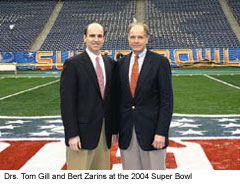 Research activities in the Sport Medicine Service are
centered on tissue engineering and biomechanics. Physicians on the service
continue to work in close collaboration with Guoan Li, PhD, Director of
the Bioengineering Laboratory. The service recently received an another
grant from the NFL to continue their studies on posterior cruciate ligament
injuries and reconstruction. They have also started a major, pioneering new
line of research into the study of knee and shoulder kinematics. Using 3-D
fluoroscopy, dynamic MRI and computer modeling, they are now able to study
the biomechanics of joints in vivo rather than relying solely on cadaveric
testing. This technique will also allow for the study of the effects of
surgical reconstructions from a biomechanical as well as subjective outcome.
Dr. Gill explains, "Historically, we have had to try to extrapolate static
cadaveric measurements from a robotic model into the clinical setting. The
truth is, without physiologic loading, we don't know how well our conclusions
mirror the clinical situation. For the first time, we can now study in vivo
kinematics and articular contact pressures both before and after reconstructive
surgery of the shoulder and knee. This breakthrough will allow us to give a
critical analysis as to the objective outcome of our reconstrutive procedures."
Mark Randolph, the laboratory director for our tissue engineering initiative,
has been a valuable collaborator for several years, and has recently become a
welcome addition to the department. Dr. Zarins, reports, "We have been working
on techniques to use collagen scaffolds and cells to allow repair of menisci
and articular cartilage. It is our hope to translate this into a clinical
trial in the not too distant future." Research activities in the Sport Medicine Service are
centered on tissue engineering and biomechanics. Physicians on the service
continue to work in close collaboration with Guoan Li, PhD, Director of
the Bioengineering Laboratory. The service recently received an another
grant from the NFL to continue their studies on posterior cruciate ligament
injuries and reconstruction. They have also started a major, pioneering new
line of research into the study of knee and shoulder kinematics. Using 3-D
fluoroscopy, dynamic MRI and computer modeling, they are now able to study
the biomechanics of joints in vivo rather than relying solely on cadaveric
testing. This technique will also allow for the study of the effects of
surgical reconstructions from a biomechanical as well as subjective outcome.
Dr. Gill explains, "Historically, we have had to try to extrapolate static
cadaveric measurements from a robotic model into the clinical setting. The
truth is, without physiologic loading, we don't know how well our conclusions
mirror the clinical situation. For the first time, we can now study in vivo
kinematics and articular contact pressures both before and after reconstructive
surgery of the shoulder and knee. This breakthrough will allow us to give a
critical analysis as to the objective outcome of our reconstrutive procedures."
Mark Randolph, the laboratory director for our tissue engineering initiative,
has been a valuable collaborator for several years, and has recently become a
welcome addition to the department. Dr. Zarins, reports, "We have been working
on techniques to use collagen scaffolds and cells to allow repair of menisci
and articular cartilage. It is our hope to translate this into a clinical
trial in the not too distant future."
The service also remains quite active nationally. Dr. Zarins
continues in his position as Consulting Editor for Sports Medicine with the
Journal of Bone and Joint Surgery and Dr. Gill has recently taken a position
on the Research Committee of the American Orthopaedic Society for Sports
Medicine.
Orthopaedic Spine Center / Orthopaedic Spine Services
The Orthopaedic Spine Center at the MGH is in its fifth year
and is now under the direction of new Spine Service Chief, Kirkham B. Wood,
MD. Dr. Wood trained and practiced at the University of Minnesota and the
Twin Cities Scoliosis-Spine Center for the past twelve years. His areas of
interest include spinal deformities both adolescent and adult, spinal tumors
and degenerative conditions of the spine.
The Orthopaedic Spine Center continues to be responsible for
all clinical, teaching and research activities related to cervical, thoracic
and lumbar spine. The members of this multi-disciplinary center are expanding
collaborations with physiatrists, the MGH Pain Center, Nurse Practitioner,
Lisa Beyer, and John James, RN, in the Access Program, to handle approximately
8,000 outpatient annual visits. Dr. Wood notes, "Clinical and basic research
are an important part of the Orthopaedic Spine Center's mission. We have
numerous clinical research investigations underway. In addition, basic science
research into the care, treatment and understanding of the spinal pathology
has begun in conjunction with the Orthopaedic Research Laboratories here at
the Massachusetts General Hospital."
Physiatrist Dr. James Sarni continues to play an important
role in the Spine Service, the Department, and the institution. Physiatrist
Dr. David Karli has recently left the MGH for the Steadman-Hawkins Clinic in
Vail, Colorado. Good luck David! The physiatrists work in collaboration with
the Department of Physical Medicine and Rehabilitation of the Spaulding
Rehabilitation Hospital. Their expertise and compassion in dealing with
patients with spinal issues has improved the quantity of care given as well
as its quality. I look forward to the many contributions that this important
service will make at the MGH and beyond.
Trauma Services
It has been another tremendously busy and productive year for
the Orthopaedic Trauma Service, under the dedicated leadership of Mark Vrahas,
MD, Partners Chief of Orthopaedic Trauma Services, and Malcolm Smith, MD,
FRCS, Chief of MGH Orthopaedic Trauma Services. Ortho DUDE (Data Utility for
Documentation and Education) the Trauma Service's multi-purpose software
application has continued to grow and expand. In its first full year of
operation, MGH trauma physicians entered more than 2,500 patients in the DUDE.
This application has already proven to be a vital part of the service's
research practice, as attendings, residents, and nursing staff regularly
request data to determine feasibility of study and/or to identify patients.
In addition, the team added a major billing component enhancement this year
including consult billing and ICD9 modules. Because DUDE is a hospital
application accessible from any Partners workstation and requires no paper,
surgeons can code their surgeries electronically in the OR, in their office
between cases, or on a patient care unit. This user-friendly process has been
a key reason in the service's dramatic reduction the lag time between the
date of surgery and the date when the bill is submitted. The DUDE's scheduling
component has been another outstanding benefit, as it has helped to improve
the trauma clinic's scheduling and patient flow operations.
Research activity within the Trauma Service continues to grow
and plans are in place to hire a full-time research nurse over the next year
to further enhance this mission. This year the trauma service has initiated
or continued work on several outcomes-related studies. Of particular note,
Dr. Vrahas and his team have been collaborating with colleagues from Boston
University's Sargent College to develop a questionnaire outcome device using
Computer Adaptive Testing (CAT) theory. This model considers subjects'
responses to certain somatic or activity questions when asking subsequent
questions. For example, if a subject's response to a question about his
ability to walk a city block demonstrates that he cannot perform this
activity, subsequent questions will be framed according to what he likely can
and cannot do based on this response. The goal of this project is to develop
a questionnaire to accurately predict long-term outcomes in trauma patients.
Other current research in this realm includes studies looking at outcomes
associated with the use of the LISS (Less Invasive Stabilization System)
plate, the AO trochanteric femoral nail, and the use of the posterior approach
in the fixation of tibial plateau fractures.
This year marks the first time the service has had two fellows:
Jack Wixted, MD, from University of Massachusetts Medical School and Tim
Bhattacharyya, MD, from Boston University Medical School. Dr. Bhattacharyya
is involved with the aforementioned posterior approach paper, and is
collaborating with Drs. Vrahas, Smith, Rubash and Richard Wiklund on the
effects a dedicated trauma room has on a variety of operational costs,
outcomes, and length of stay. He has also submitted an abstract concerning
the effects of NSAIDS on non-unions, and his paper with Dr. Vrahas entitled
The Medical-Legal Aspects of Compartment Syndrome was recently accepted by JBJS.
Dr. Wixted is very interested in surgical navigation and is
taking the lead on an industry trial evaluating ease of use of a C-arm
containing this capability. He is working with Dr. Smith on a paper evaluating
the use of a modified Kocher-Langenbach approach in the fixation of acetabular
fractures, and is one of the co-investigators in the aforementioned
trochanteric femoral nail study.
In January, the service hosted the highly successful Third
Annual New England Trauma Summit at Sunday River, Maine. The summit attracts
talented faculty from New England and New York. The format, consisting of
lectures and extensive case discussion, has been extremely well received and
has generated a strong following.
In the service's other education news, the Trauma Service
again hosted numerous AO fellows, independent fellows, and medical students.
Congratulations to the members of the Trauma Service on all their great work!
RESEARCH UPDATES:
Orthopaedic Biomechanics and Biomaterials Laboratory (OBBL)
The Orthopaedic Biomechanics and Biomaterials Laboratory (OBBL),
led by William H. Harris, MD, and Deputy Director, Orhun Muratoglu, PhD,
continues to play a significant role in total joint arthroplasty research
with many innovative contributions. The OBBL pioneered in fields of cementing
techniques, hip and knee implant design, revision total hip arthroplasty
techniques, biology of bone in growth and in the area of highly crosslinked
polyethylenes. We are pleased to announce Drs. Harris and Muratoglu were
joined this year by, Dr. Henrik Malchau. Dr. Harris reports, "We are very
pleased to announce that Dr. Henrik Malchau has joined us as Co-Director of
the Orthopaedic Biomechanics and Biomaterials Laboratory and a member of the
Adult Reconstruction Unit. He is a world recognized expert in outcomes studies,
the former director of the Swedish National Registry and an expert in
radiostereometric analysis."
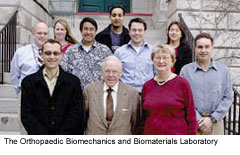 Currently two clinical studies, one in its 3rd year, are
underway using radiostereometric analysis (RSA) technique to determine the
wear behavior of highly crosslinked polyethylenes when used in conjunction
with large head femoral components. The OBBL has also initiated efforts to
use RSA techniques to investigate total knee kinematics in vivo. The OBBL
is also focusing on novel crosslinked polyethylenes with low wear and high
fatigue strength for applications in high-stress total knee replacements.
Under the direction of Dr. Muratoglu, the team has added two new inventions
to their already strong intellectual property portfolio: two novel methods
of improving the fatigue resistance of highly crosslinked polyethylenes,
one using mechanical annealing and the other using vitamin-E to stabilize
the residual free radicals and plasticize the base polymer. In addition,
the laboratory is initiating collaborations with Dr. Kirk Wood for identifying
research focus areas in the spine. Dr. Jeeyoung Choi is joining the team as a
postdoctoral fellow this year to work on the development of alternative
therapies for nuclear augmentation using synthetic hydrogels. Currently two clinical studies, one in its 3rd year, are
underway using radiostereometric analysis (RSA) technique to determine the
wear behavior of highly crosslinked polyethylenes when used in conjunction
with large head femoral components. The OBBL has also initiated efforts to
use RSA techniques to investigate total knee kinematics in vivo. The OBBL
is also focusing on novel crosslinked polyethylenes with low wear and high
fatigue strength for applications in high-stress total knee replacements.
Under the direction of Dr. Muratoglu, the team has added two new inventions
to their already strong intellectual property portfolio: two novel methods
of improving the fatigue resistance of highly crosslinked polyethylenes,
one using mechanical annealing and the other using vitamin-E to stabilize
the residual free radicals and plasticize the base polymer. In addition,
the laboratory is initiating collaborations with Dr. Kirk Wood for identifying
research focus areas in the spine. Dr. Jeeyoung Choi is joining the team as a
postdoctoral fellow this year to work on the development of alternative
therapies for nuclear augmentation using synthetic hydrogels.
On an annual basis the Laboratory brings in over $3 million
in funding from a variety of foundations, industry, and government sources.
Congratulations to Dr. Muratoglu and team for their new R01 NIH grant,
"Fatigue Resistant Crosslinked UHMWPE for Total Joints" and their OREF grant
in the same area of research, both of which were awarded this year. The OBBL
is over-flowing with new activity and energy. The skillful scientists in the
lab had a phenomenal year at the ORS with 40 podium, posters, and scientific
exhibits. Congratulations to the members of the OBBL on these outstanding
accomplishments!
The Biomaterials Laboratory guided by Arun Shanbhag, PhD, MBA
is working to identify new technologies to enhance our understanding of aseptic
loosening and osteolysis. Researchers in the Biomaterials Laboratory have
recently used complimentary DNA microarrays to investigate the gene expression
profile of macrophages in their interaction with wear debris from joint
replacements. Using a variety of bioinformatics tools such as cluster analysis
and self organizing maps, they have confirmed the role of many genes and
identified yet novel genes up-regulated as a consequence of the biomaterial
interaction. These studies should help to pinpoint critical genes participating
in aseptic loosening.
Dr. Koichiro Hayata from Tokyo Women's Hospital is leading
studies in our laboratory to better define the role of bisphosphonates in
stimulating new bone. The laboratory is collaborating with the Bauer Center
for Genomics Research at Harvard University for these analyses. Working with
the Harvard Partners Center for Genetics and Genomics they are using high
throughput Protein Chips to analyze the inflammatory cytokine profile in
aseptic loosening. Collaborations are also underway with deCODE Genetics to
identify the genetic markers associated with osteoarthritis. These long-term
studies will ensure the penetration of genomic technologies in clinical
orthopaedics.
Bioengineering (Robotics) Laboratory
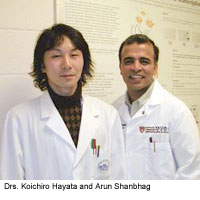 Guoan Li, PhD, and members of the Bioengineering Laboratory
continue to pursue an accurate understanding of in vivo knee joint kinematics
function to improve flexion after knee arthroplasty or ligament reconstruction.
In vivo MRI combined with 3D fluoroscopy studies and robotic testing are being
utilized to provide baselines for the development of new concepts in total knee
arthroplasty, unicompartmental knee arthroplasty, anterior and posterior
cruciate ligament research, and studies of the function of the upper extremity.
There are several Robotic Teams: Sports Medicine, Hand and Upper Extremity,
Joint Kinematics, and Total Joint (including unicompartmental) Arthroplasty
teams. Three new In-vivo Teams have been recently formulated: In-vivo Knee
Arthroplasty, In-vivo Cruciate Reconstruction and In-vivo Upper Extremity
teams. These research teams are utilizing the robotic testing system and
advanced imaging techniques to develop new concepts in the understanding
of musculoskeletal joint functions. Guoan Li, PhD, and members of the Bioengineering Laboratory
continue to pursue an accurate understanding of in vivo knee joint kinematics
function to improve flexion after knee arthroplasty or ligament reconstruction.
In vivo MRI combined with 3D fluoroscopy studies and robotic testing are being
utilized to provide baselines for the development of new concepts in total knee
arthroplasty, unicompartmental knee arthroplasty, anterior and posterior
cruciate ligament research, and studies of the function of the upper extremity.
There are several Robotic Teams: Sports Medicine, Hand and Upper Extremity,
Joint Kinematics, and Total Joint (including unicompartmental) Arthroplasty
teams. Three new In-vivo Teams have been recently formulated: In-vivo Knee
Arthroplasty, In-vivo Cruciate Reconstruction and In-vivo Upper Extremity
teams. These research teams are utilizing the robotic testing system and
advanced imaging techniques to develop new concepts in the understanding
of musculoskeletal joint functions.
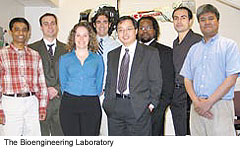 The laboratory recently celebrated the graduation of Ephrat
Most with a PhD in Mechanical Engineering at MIT. She has been an integral
member of the laboratory since 1998 and concentrated on the experimental
and theoretical modeling of the knee and TKA in high flexion. Louis DeFrate,
also a MIT graduate student, has been with the laboratory since 1999. Lou's
work focuses on the optimal reconstruction of the PCL using theoretical
analysis and experimental validation. Jeremy Suggs, another MIT graduate
student, joined the Lab in 2000 to study the mechanisms of treating the
osetoarthritic knee using unicompartmental knee arthroplasty. Janine Pierce,
a MIT graduate student, joined the laboratory in 2001and has been developing
a converging optimization method to accurately predict in-vivo muscle
contraction forces and joint reaction forces of musculoskeletal systems. Dr.
Sang Eun Park, an orthopaedic surgeon from South Korea, has actively
participated in a variety of clinical and robotic projects. The team had
over 10 podium, posters and exhibits at this year's ORS meeting. The laboratory recently celebrated the graduation of Ephrat
Most with a PhD in Mechanical Engineering at MIT. She has been an integral
member of the laboratory since 1998 and concentrated on the experimental
and theoretical modeling of the knee and TKA in high flexion. Louis DeFrate,
also a MIT graduate student, has been with the laboratory since 1999. Lou's
work focuses on the optimal reconstruction of the PCL using theoretical
analysis and experimental validation. Jeremy Suggs, another MIT graduate
student, joined the Lab in 2000 to study the mechanisms of treating the
osetoarthritic knee using unicompartmental knee arthroplasty. Janine Pierce,
a MIT graduate student, joined the laboratory in 2001and has been developing
a converging optimization method to accurately predict in-vivo muscle
contraction forces and joint reaction forces of musculoskeletal systems. Dr.
Sang Eun Park, an orthopaedic surgeon from South Korea, has actively
participated in a variety of clinical and robotic projects. The team had
over 10 podium, posters and exhibits at this year's ORS meeting.
Cartilage Biology and Orthopaedic Oncology Laboratories
The Cartilage Biology and Orthopaedic Oncology Laboratories are
under the direction of Drs. Christine A. Towle and Henry Mankin. The laboratories
continue to focus on molecular and biochemical markers that may serve as
predictors of metastasis in bone and soft tissue tumors. Dr. Towle's research
team is exploring the mechanisms leading to cartilage damage. In particular,
the group is interested in understanding the soluble and mechanical factors
that regulate the integrity of the articular cartilage in both health and
disease. Recent research from the laboratory has demonstrated that some of
the effects of mechanical stimulation on cartilage are mediated through the
IL-1 receptor, and a new NIH grant from the National Institute of Aging
supports further investigation of the role of IL-1 in mechanical signal
transduction. Congratulations Chris and team for obtaining a new NIH grant!
The laboratories have access to data from a computerized
database with information on over 15,000 patients treated by the Orthopaedic
Oncology Service. This data has been used in numerous clinical studies. Dr.
Mankin has a clinical interest in skeletal problems in patients with Gaucher's
disease. Through the use of a questionnaire, "quality of life" issues for these
patients are being explored. Dr. Mankin's clinical research projects are
supported by corporate funding and donations from patients and their families.
The work of the Cartilage Biology Laboratories continues its long history of
NIH funding.
Sarcoma Molecular Biology Laboratory
The Sarcoma Molecular Biology Laboratory continues under the
direction of Lawrence Weissbach, PhD, MBA, and Francis Hornicek, MD, PhD, is
investigating tumor physiology and novel chemotherapeutic agents to further
advance the treatment of malignant tumors. The Laboratory is investigating
ways that chondrosarcoma cells may develop resistance to chemotherapeutic
agents. Dr. Weissbach explains, "The overall objectives of this laboratory
are to explore biological mechanisms of tumors arising in bone and soft
tissues, and perform translational research in new treatment options for
patients afflicted with musculoskeletal tumors. For certain tumors, such as
chondrosarcoma, treatment options are limited once the tumor has metastasized,
and this laboratory is interested in improving existing therapies as well as
devising novel treatments for these tumors."
Members of the laboratory are working on a number of novel
research programs and have collaborated with researchers at Children's
Hospital in Boston, Carnegie Mellon University, the University of Bern
in Switzerland, and PharmaMar in Spain. This laboratory has published
numerous articles pertaining to sarcoma biology, and has received funding
from a variety of sources, including foundations, corporate sponsors,
and benefactors.
Laboratory of Orthopaedic Biochemistry and Osteoarthritis Therapy
Teresa Morales, PhD, directs the Laboratory of Orthopaedic
Biochemistry and Osteoarthritis Therapy. Dr. Morales explains the mission of
the Laboratory is "to understand the role of key signaling and matrix factors
in the regulation of chondrocyte biology and to apply this knowledge towards
investigations of cartilage repair." Another key goal is to understand
chondrocyte migration and to develop new avenues of cartilage repair. Results
in these efforts were reported at this year's Orthopaedic Research Society
Meeting and in the Journal of Orthopaedic Research, Cartilage and Osteoarthritis
and the Archives of Biochemistry and Biophysics.
Recent members of the laboratory include Amar Mutnal, a summer
medical student intern from the University of Michigan, and Xia Liu, a part
time technician. Lihua Zhang is the senior technician in the laboratory, and
joined the laboratory this year after many years of experience in Pediatric
Endocrinology here at MGH. Ravina Dial is another technician who recently
joined the laboratory for a year. Key collaborators with Dr. Morales include:
Dr. Ernst Hunziker, Director Muller Institute of Biomechanics; Dr. Douglas
Lauffenburger, Director, Division of Biological Engineering, MIT; and Drs.
Joseph Buckwalter and James Martin, University of Iowa. The Laboratory's
funding includes an R21 and a new R01 grant from the NIH. Congratulations
to Dr. Morales for her noteworthy accomplishments!
Laboratory for Musculoskeletal Tissue Engineering
Mark Randolph joined the Department last year to work with
Dr. Thomas Gill and the Sports Medicine Service on cartilage repair and
regeneration in the knee in a new Laboratory for Musculoskeletal Tissue
Engineering on Jackson 11. Mark brings close to a dozen years of experience
in cartilage tissue engineering in the MGH Plastic Surgery Research Laboratory.
Along with Dr. Gill, Mark is exploring tissue engineering approaches for
meniscal and articular surface repair. Collaboration continues with Dr.
Giuseppe Peretti from Milan, Italy, on a swine model for meniscal tears
treated with an engineered implant. This work was published in the American
Journal of Sports Medicine in January 2004. New studies are underway exploring
alternative cell sources and new scaffold materials. The other primary focus
of the laboratory is engineering cartilage to repair articular surface defects.
Working with chemical engineering teams from MIT and University of Colorado,
new polymer carriers are in development and testing. Results of these new
approaches were presented at this year's Orthopaedic Research Society Meeting
in San Francisco.
Biomotion Laboratory
The Biomotion Laboratory in Ruth Sleeper Hall is directed by
David Krebs, DPT, PhD.. Dr. Krebs teaches advanced statistics to graduate
students and holds academic appointments in the Department of Orthopaedic
Surgery and in Mechanical Engineering at MIT.
Dr. Krebs explains, "The mission of the MGH Biomotion
Laboratory is to better understand the biomechanical and neural constraints
of human movement. The major goals are to investigate the means by which body
segment kinematics and kinetics are governed by neuropathic and arthropathic
conditions. Our objectives include determining the means by which humans
compensate for and adapt to, specific orthopaedic and neurophysiological
motor deficits. We employ state-of-the art modeling, theory and data
acquisition to generate appropriately detailed analyses of impairments,
organ level function or dysfunction, functional limitations, and whole
person function or dysfunction, ,as well as medical imaging techniques
such as MRI to quantify the internal derangement of the joints." We look
forward to collaborations with Dr. Krebs and his team and our MIS Team.
Annual Turkey Bowl
For the past five years, Dr. Jupiter has organized the annual
November Turkey Bowl which pits orthopaedic attendings and fellows against
residents in a rough and tumble touch-football game. Dr. Jupiter, reports,
"As time has progressed the residents seem younger and faster and are now
winning convincingly. The past 2 years have been injury free but in prior
years we have had some hard knocks." It was a great game this year and I
was glad to participate. The weather was beautiful and a fantastic game was
followed by a bagel and beer celebration.
Annual Children's Holiday Party
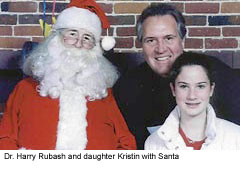 Our Fourth Annual Children's Party at the Children's Museum
in Boston was a complete joy. Nearly 100 family members joined us this year
for an afternoon filled with smiles and fun. The day's events included lunch
followed by holiday cake and ice-cream in a private room at the Museum. Of
course Santa and his elves were there and we were also entertained by a
professional folk-singer. All of the children were presented with gifts and
goody-bags. We were pleased to have Michelle Rose of MGH Photography onsite
and everyone went home with a family picture taken with Santa and the elves.
Thank you to Joseph Czarnecki, MD, PGY 5, who diligently worked to make this
year's party truly a magic time for young and old. Our Fourth Annual Children's Party at the Children's Museum
in Boston was a complete joy. Nearly 100 family members joined us this year
for an afternoon filled with smiles and fun. The day's events included lunch
followed by holiday cake and ice-cream in a private room at the Museum. Of
course Santa and his elves were there and we were also entertained by a
professional folk-singer. All of the children were presented with gifts and
goody-bags. We were pleased to have Michelle Rose of MGH Photography onsite
and everyone went home with a family picture taken with Santa and the elves.
Thank you to Joseph Czarnecki, MD, PGY 5, who diligently worked to make this
year's party truly a magic time for young and old.
Personal Note
This winter was marked as the second-coldest January in
recorded weather history, with three weeks of sub-freezing temperatures.
The last time it was this cold was over a century ago! Back then Teddy
Roosevelt was the President of the United States and Joel E. Goldthwait,
MD, was the first Chief of Orthopaedic Surgery at the MGH.
Our children continue to grow and flourish. Brad, age 17,
will be a senior in the fall at Weston High School. Steven, age 15, will
be a junior and Kristin, age 13, will be a 9th grader. We anticipate much
activity this year as we prepare for Brad's entrance into college and also
prepare Steven and Kristin for their collegiate years as well. We have
reached out and developed more friendships in the Weston community and the
MGH community and I appreciate all of the help and support I have gotten
from both groups during this year.
This was a hallmark year for me as I have entered my 5th
decade of life. My birthday present from my family was a week heliskiing
in the Canadian Rocky Mountains with Canadian Mountain Holidays (CMH) at
the Caribou Lodge. This was an incredible event for me and encompassed a
variety of emotions from abject fear to elation. The weather was iffy at
times, the alpine skiing was fabulous, and the tree skiing was … how can
I say it, I barely survived. It was a wonderful experience and one that I
will cherish throughout my life.
The past six years have been extremely rewarding for me.
The difficult days in the first couple of years during the transition have
turned to distant memories and now I am working to make our Department a
cohesive, collegial, focused academic group -- we are "striking the right
balance." We have developed world-class clinical divisions and research
laboratories and have recruited some fine individuals to join the members
of the existing faculty. With the addition of an MD/PhD program in the
laboratories this year and the expansion of our translation research programs
I know that we will continue to advance the Department of Orthopaedic Surgery
at the Massachusetts General Hospital.
|

